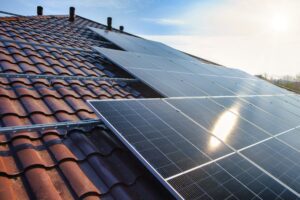Rooftop solar panels are a common sight in neighbourhoods. But have you heard about the latest in solar technology?
Windows are now being developed that generate free renewable electricity while still letting daylight in. Solar windows are emerging thanks to cutting-edge tech and they’re already here, albeit to a limited extent.
But could these really be the windows of the future? Our guide tells you everything you need to know about solar windows, including:
- How solar window glass works.
- How solar power windows were developed.
- Who’s making them.
- Potential applications of solar windows.
- Solar window pros and cons.
How Solar Windows Work
Solar technology is based on photovoltaics. This is a phenomenon in physics and chemistry. It enables a semiconducting material like silicon cells in solar photovoltaic (PV) panels to create electricity from electromagnetic energy that radiates from the sun. Solar power windows do the same job.
For years, windows have remained pretty much the same. Despite developments such as uPVC double glazing, they’re still just glass panes in a frame, which give us a view of the outside world.
But pioneering solar technology could change that, with windows made of partially or completely transparent photovoltaic glass that generates electricity like rooftop solar panels.
- Create a Tailored Quote Based On Your Circumstances
- Takes Less Than 2 Minutes
- Fixed-Online Quotes

Building Integrated Photovoltaics
Solar windows fall into the category of building-integrated photovoltaics (BIPV), along with roof-integrated solar panels.
They look like conventional windows but a transparent solar coating is built into the glass during the manufacturing process. This collects some of the light energy passing through the window and turns it into electricity to power appliances.
At the same time, the glass still allows light into your home. Unlike solar panels, solar windows allow penetration of visible light. They only absorb energy from the invisible infrared and ultraviolet parts of the electromagnetic spectrums.
Researchers have also been working on sandwiching semi-transparent light absorbers in the gap between the two panes of a double-glazed window.
Other BIPV solar window developments include:
- Micro solar panels on the sides of windows or in the corners.
- Photovoltaic film or ink sprayed onto the glass surface. This can be done with existing windows or during the manufacturing process.
- Nano PV solar cells – quantum dots – embedded into the glass. The Ecole Polytechnique Federale de Lausanne (EPFL) in Switzerland is already working on this technology.
How Solar Windows Were Developed
The first prototypes of windows that produce solar energy were developed in the 1980s.
The big breakthrough came some 20 years later by researchers at Massachusetts Institute of Technology (MIT) and Michigan State University (MSU). Over a decade, they developed 100 percent transparent photovoltaic glass using a coating of semiconducting materials to convert sunlight into electricity.
The researchers were quick to spin the development out onto the solar market, with a company called Ubiquitous Energy, founded in 2011 and based in Silicon Valley. They claimed their trademarked solar window product UE Power was the world’s first aesthetically acceptable solar window. It had ambitious plans to turn office skyscrapers into vertical solar farms and also aimed to target the residential market.
However, in April 2024 the company began sacking staff. It remained tight-lipped about the future of Ubiquitous Energy but insiders said they expected it to go out of business within a matter of weeks.
Since Ubiquitous Energy’s scaleback, other companies have begun developing similar technology.
Who Makes Solar Windows?
According to global market research consultancy Mordor Intelligence, key players in the solar power window market include:
- Physee in the Netherlands, with its PowerWindow and SmartWindow products.
- Brite Solar, a nanomaterials company in Colorado, USA.
- Solaria Corporation, headquartered in California.
- Energy Glass, now part of Singapore-based Maxeon Solar Technologies.
Several other manufacturers are also in the vanguard of solar panel window development and manufacturing.
Based in Spain and founded in 2009, Onyx Solar claims it’s the world’s leading manufacturer of transparent solar power windows for buildings, and it uses layers of heat-treated safety glass. The company has already installed these products for major corporations such as Microsoft, American Airlines, McDonald’s, and Coca-Cola.
In the UK, Cambridge-based Polysolar has been working on next-generation photovoltaic materials since 2007. These include architectural solar glass for homes. The company has used thin-film photovoltaic technology to develop solar window panels in various transparencies, with up to 80 percent light penetration and efficiency levels of 12 to 15 percent.
- Create a Tailored Quote Based On Your Circumstances
- Takes Less Than 2 Minutes
- Fixed-Online Quotes

Potential Uses Of Solar Windows for Homes
Residential PV glass is unlikely to provide an alternative to rooftop solar panels anytime soon. The technology is currently significantly less efficient than conventional solar panels.
But despite the limitations, solar windows have potential in complementing rooftop solar panels by powering certain appliances. With an electrical port on the window frame, you could be able to charge your phone, laptop and other devices, for example.
Other applications of solar windows could include automating operations of the window itself, such as opening and closing blinds. Solar panel windows also open up possibilities of more advanced window technology like electrochromic glass, which would make them dimmable.
We could see solar windows for homes connected to a micro battery backup system and possibly wired to electrical control panels. However, it may be challenging to find ways to connect the multiple points of electricity produced in a solar window to a bigger battery or the grid.
Solar Window Pros And Cons
If your roof isn’t suitable for solar panels, solar power windows could provide you with a limited amount of free electricity. And you may be able to sell some of it. (More on this later). But solar windows may be expensive and not to the liking of all homeowners.
Advantages Of Solar Windows
Solar windows generate a certain amount of free electricity, which reduces energy bills to some extent. Other benefits of solar windows for homes include blocking UV light, helping with privacy and security, and providing insulation.
Blocking Ultraviolet Radiation
UV light from the sun that enters properties via windows can result in premature ageing of the skin and cause colours of home furnishings and fabrics to fade. Solar windows absorb ultraviolet radiation, preventing it from penetrating into buildings.
Privacy And Security
Solar windows that are tinted improve privacy by making it harder to see into a property. This could also deter potential intruders. Furthermore, it reduces glare on TV and computer screens.
Insulation
Double-pane solar windows provide thermal and sound insulation. This cuts heating costs and reduces the effects of external noise pollution.
Disadvantages Of Solar Windows
One drawback of solar power windows could be the price. With solar window glass still a developing technology, potential costs of solar windows for homes are difficult to predict. But it looks like they won’t come cheap. This is because of limited supply and complexity of installation. That said, solar windows are likely to last up to twice as long as rooftop solar panels – 50 years compared with 25 to 30 years, so you get more for your money.
A further downside of many solar windows is that they’re only partially transparent at the moment. This optimises efficiency. The resulting tint may help with privacy and security, but doesn’t provide a practical, straight alternative to traditional, clear glazing. However, tinted solar windows may be desirable in some cases, such as glazing for conservatories that provides shade in direct sunlight.
Other disadvantages of solar windows include an unstable electricity supply. Cloudy weather hinders absorption of solar energy.
Solar Windows And The Smart Export Guarantee
Like rooftop solar panels, solar power windows only generate electricity during daylight hours. This is when a household’s need for power is typically lower, so you may end up with surplus solar energy.
If you have a solar battery, you can store this energy for use during the evenings when electricity demand generally peaks. Otherwise it goes to the National Grid. But you can get paid for it through the Smart Export Guarantee (SEG), too.
Under the scheme, major energy providers pay varying tariffs for each unit of solar electricity sent to the mains supply grid.
Are Solar Windows The Future In The UK?
Solar power windows promise huge benefits in the battle to combat climate change with green energy. At the moment, they’re in the experimental stage and not widely available. A future where solar windows power skyscrapers and entire green cities may seem like the stuff of science fiction, but it could be closer than we think. After all, at one point who would have believed we could use our roofs to make electricity?
Solar windows may be some way off a mainstream solution, but if you’re an eco-conscious homeowner they could be worth keeping an eye on. And with increased availability of solar windows for homes, they just might be the next big thing in residential renewable energy – fully transparent photovoltaic windows using nanotechnology.
Meanwhile, rooftop solar panels continue to be the key for households looking for renewable electricity that significantly cuts energy bills and reduces carbon emissions.
- Create a Tailored Quote Based On Your Circumstances
- Takes Less Than 2 Minutes
- Fixed-Online Quotes




